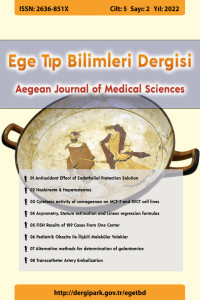Öz
Amaç: Bu çalışmada, pediatrik obezite ile ilişkili olası moleküler mekanizmaları araştırmak için obezite tanısı konmuş çocuklarda, obezitede rol oynayan potansiyel anahtar genleri ve yolakları belirlemek için biyoinformatik analiz yapılmıştır.
Gereç ve Yöntem: Biyoinformatik analiz için GEO veri tabanından pediatrik obezite verilerine ait GSE9624 ve GSE139400 erişim numarasına sahip ekspresyon verileri seçilmiştir. GSE9624 veri seti 14 obez ve 13 obez olmayan çocuktan, GSE139400 veri seti ise 5 Obez ve 5 normal kilolu çocuklardan alınan adipoz doku ve kan örnekleri örnekler ile çalışılmıştır. Obez çocuklardan alınan örneklerle normal kilolu çocuklardan alınan örnekler farklı şekilde ifade edilen genleri (DEG) bulmak için GEO2R ile analiz edildi. DEG’ler için GO ve KEGG zenginleştirme analizleri gerçekleştirilmiştir. Cytoscape yazılımıyla bir protein-protein etkileşimi (PPI) ağı oluşturuldu ve obezite ile ilişkili önemli genler belirlendi.
Bulgular: GEO2R ile analiz sonucunda p değeri <0.05 ve log2FC≥0 veya ≤0 olan DEG'ler seçildi. GSE9624 veri setinde obezite grubunda kontrol grubuna göre 1933 genin ifadesi artarken 1462 genin ifadesi azalmıştır. GSE139400 veri setinde ise obezite grubunda kontrol grubuna göre 725 genin ifadesi artarken 1372 genin ifadesi azalmıştır. Her iki veri setinde ortak olarak ifadesi artan 89, ifadesi azalan 161 DEG tanımlanmıştır. İfadesi değişen genlerin lipit ve ateroskleroz, Doğal öldürücü hücre aracılı sitotoksisite, mTOR sinyal yolağı ve paratiroid hormon sentezi, salgılanması ve etkisi yolaklarında toplandığı görülmüştür. Ayrıca, ALB, RHOA, KRAS, CREB1, GNAQ, GATA3, CXCR3, EZR, SERPINA1, GNAO1 genleri en önemli genler arasında çıkmıştır.
Sonuç: Bu çalışmanın sonuçları, ortaya çıkan yolak ve genlerin pediatrik obezitede önemli bir rolü olabileceğini göstermiştir
Anahtar Kelimeler
Kaynakça
- 1-Lobstein T, Baur L, Uauy R. IASO International Obesity TaskForce. Obesity in children and young people: a crisis in public health. Obes Rev 2004; 5 (Suppl. 1): 4–104.
- 2-. Gupta N, Goel K, Shah P, Misra A. Childhood obesity in developing countries: epidemiology, determinants, and prevention. Endocr Rev 2012;33:48-70.
- 3- Ahrens W, Moreno LA, Pigeot I . Childhood obesity: prevalence worldwide—synthesis part I. In: Moreno LA, Pigeot I, Ahrens W (eds). Epidemiology of Obesity in Children and Adolescents—Prevalence and Etiology. Springer Publisher, New York, USA, 2011, pp 219–235.
- 4- Sun K, Kusminski CM, Scherer PE. Adipose tissue remodeling and obesity. J Clin Invest. 2011;121 (6):2094–2101.
- 5-Wang J, Zhang C. Identification and validation of potential mRNA- microRNA- long-noncoding RNA (mRNA-miRNA-lncRNA) prognostic signature for cervical cancer. Bioengineered. 2021;12(1):898–913.
- 6- Chait A, LJ DH. Adipose tissue distribution, inflammation and its metabolic consequences, including diabetes and cardiovascular disease. Front Cardiovasc Med. 2020;25(7):22.
- 7- Jung UJ, Choi MS. Obesity and its metabolic complications: the role of adipokines and the relationship between obesity, inflammation, insulin resistance, dyslipidemia and nonalcoholic fatty liver disease. Int J Mol Sci. 2014;15(4):6184–6223.
Öz
Objective: In this study, it was aimed to identify potential key genes and pathways that play a role in obesity in children diagnosed with obesity in order to investigate possible molecular mechanisms associated with childhood obesity.
Materials & Methods: Expression data of pediatric obesity data with accession numbers GSE9624 and GSE139400 were selected from the GEO database for bioinformatics analysis. The GSE9624 dataset was studied with samples from 14 obese and 13 non-obese children, and the GSE139400 dataset was studied with samples of adipose tissue and blood samples from 5 obese and 5 normal-weight children. Samples from obese children and samples from normal-weight children were analyzed by GEO2R to find differentially expressed genes (DEG). GO and KEGG enrichment analyzes were performed for DEGs. A protein-protein interaction (PPI) network was created with the Cytoscape software and important genes associated with obesity were identified.
Results: DEGs with a P-value <0.05 and log2FC≥0 or ≤0 as a result of analysis with GEO2R were selected. In the GSE9624 dataset, the expression of 1933 genes increased in the obesity group compared to the control group, while the expression of 1462 genes decreased. In the GSE139400 data set, while the expression of 725 genes increased in the obesity group compared to the control group, the expression of 1372 genes decreased. In both data sets, 89 DEGs with increased expression and 161 DEGs with decreased expression were identified. It has been observed that the genes whose expression changes are collected in Lipid and atherosclerosis, Natural killer cell mediated cytotoxicity, mTOR signaling pathway and Parathyroid hormone synthesis, secretion and effect pathways. In addition, ALB, RHOA, KRAS, CREB1, GNAQ, GATA3, CXCR3, EZR, SERPINA1, GNAO1 genes were among the most important genes.
Conclusion: The results of this study showed that emerging pathways and genes may have an important role in childhood obesity.
Anahtar Kelimeler
pediatric obesity gene expression bioinformatics analysis GEO microarray
Kaynakça
- 1-Lobstein T, Baur L, Uauy R. IASO International Obesity TaskForce. Obesity in children and young people: a crisis in public health. Obes Rev 2004; 5 (Suppl. 1): 4–104.
- 2-. Gupta N, Goel K, Shah P, Misra A. Childhood obesity in developing countries: epidemiology, determinants, and prevention. Endocr Rev 2012;33:48-70.
- 3- Ahrens W, Moreno LA, Pigeot I . Childhood obesity: prevalence worldwide—synthesis part I. In: Moreno LA, Pigeot I, Ahrens W (eds). Epidemiology of Obesity in Children and Adolescents—Prevalence and Etiology. Springer Publisher, New York, USA, 2011, pp 219–235.
- 4- Sun K, Kusminski CM, Scherer PE. Adipose tissue remodeling and obesity. J Clin Invest. 2011;121 (6):2094–2101.
- 5-Wang J, Zhang C. Identification and validation of potential mRNA- microRNA- long-noncoding RNA (mRNA-miRNA-lncRNA) prognostic signature for cervical cancer. Bioengineered. 2021;12(1):898–913.
- 6- Chait A, LJ DH. Adipose tissue distribution, inflammation and its metabolic consequences, including diabetes and cardiovascular disease. Front Cardiovasc Med. 2020;25(7):22.
- 7- Jung UJ, Choi MS. Obesity and its metabolic complications: the role of adipokines and the relationship between obesity, inflammation, insulin resistance, dyslipidemia and nonalcoholic fatty liver disease. Int J Mol Sci. 2014;15(4):6184–6223.
Ayrıntılar
| Birincil Dil | Türkçe |
|---|---|
| Konular | Klinik Tıp Bilimleri |
| Bölüm | Orijinal Araştırma |
| Yazarlar | |
| Erken Görünüm Tarihi | 31 Ağustos 2022 |
| Yayımlanma Tarihi | 31 Ağustos 2022 |
| Kabul Tarihi | 28 Ağustos 2022 |
| Yayımlandığı Sayı | Yıl 2022 Cilt: 5 Sayı: 2 |



